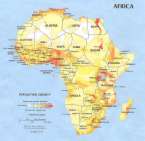GW in JA: The Selling of Jamaica
 by John Maxwell
by John MaxwellSpecial to Global Wire
The Spanish are becoming extremely protective about the integrity of their coastline. After forty years of breakneck tourism development, the Spaniards have looked at their 8,000 km of sea coast and they don’t like what they see.
Spain is the world’s second most popular tourist destination after the United States, annually attracting 10 million more tourists than the 40 million people of the country. Tourism, as in Jamaica produces about ten percent of GDP, but in Spain most of the money remains in the country, unlike Jamaica where much of it it leaks back out to the United States for supplies and to Cayman and other such havens for numbered bank accounts.
Cheap air fares were the stimulus for the Spanish hotel boom, and the result is a wall of concrete cutting off the Spaniards from their coast. Forty years of uncontrolled building of tourist hotels have left Spaniards agonising about the beauty and amenity they have lost. Isabel Soto, writing seventeen years ago in the New York Times complained that “ the idyllic Spanish Mediterranean coast [has been transformed] into an often nightmarish urban wall of big, unattractive hotels and apartment blocks, often with scant attention to environmental basics like clean beaches.”
Since then it has simply got worse, to the point where the Spanish environmentalists are complaining that their coasts have been almost completely destroyed. Instead of rocky headlands, bird filled marshes, long sweeps of beach and wilderness, , the coast is now a wall of hotels and apartments, massive avalanches of concrete occluding hiullsides, fronted by beaches pullulating in bodies like a St Elizabeth rice field under attack by the fall army worm.
The European tourism market is increasingly a mass escape from anywhere to anywhere, with young people looking for surcease from the Mcdonaldisation of the workplace. What is important is sun, sex and booze, and some people will only be able to say where they spent their holidays by checking their credit card records
But, never mind, pouring concrete was the simplest make to coin money, in hotels and apartments which replicate the banal frenzy for kilometer after boozy kilometer. Nothing about the experience is Spanish – even the gigolos have been globalised.
It is no wonder that an increasing number of Spaniards want their country back, want to preserve some of what was there before the attack of unsustainable tourist mega-development. They have begun to organise to stop the triumph of concrete over common sense.
The same thing is beginning to happen at the other end of Europe. In Bulgaria’s Black Sea coast, growing ever more popular as a destination of those in the know, the construction of hotels and apartments is proceeding apace, rather like Spain a decade and a half ago. Writing for the Environmental News Service, Tatyana Dimitrova says “…not all of the rapid development has been viable or well planned. Lax state control and imperfect legislation have resulted in massive overbuilding on the Black Sea coast, and recently also in mountain ski resorts.
“While much effort has gone into the building of hotels, restaurants and other tourist buildings, little care has been taken of the urban infrastructure or the remaining green spaces.
“The gloomy precedent of Spain's Costa del Sol is increasingly spoken about as a warning of what can happen to a tourist industry if it is allowed to develop with no controls. Wholesale construction of densely packed high-rises all along the Costa del Sol in the 1960s and '70s resulted in a flight of better-off visitors to less "spoiled" resorts, leaving hoteliers in charge of empty buildings – a phenomenon known as "dead zones’”
The point is, of course, that people whether visitors or natives, are people first, and in traveling, they are most stimulated by meeting and interacting with people of other cultures. The Jamaican experience is what draws people to jamaica but often they are short-changed and given an ersatz version of the Jamaican reality, complete with fire eaters and limbo dancers while Choucoune, aka ‘Yellow Bird’ has died a million deaths at the hands of mento bands and Jamaican cuisine is apotheosised in Ackee and Saltfish
There is another jamaica, in fact several other Jamaicas, but the competitive pressure does not allow many of our resorts to give foreign visitors any taste of them any more than the visitors to Spain gain any insight into the rich cultures of that country.
The Spaniards are getting so tired of the misrepresentation of their country that a backlash has set in. In several places on the Spanish coasts, municipalities, pressured by the citizenry, are making more stringent regulations governing the number and size of hotels and pushing them back from the beach, which is being reclaimed for the public.
There is news to give Jamaican capitalists fits: the Spanish municipalities are condemning some of these hotels, some only half-built, and are demolishing them, blowing them up with dynamite and flattening them with bulldozers.
They want their beaches, their environment and their culture back.
Pear Tree Bottom
In his judicial review of the Pear tree Bottom debacle, Mr Justice Sykes made several unassailable points as to the almost absolute worthlessness of the Environmental Impact Assessment – EIA. An EIA is a mechanism by which the society decides whether it wants to do some work that will have serious effects on the lives of its members.
The first function of an EIA is to advise on whether there are alternatives to the proposed development, and to evaluate those alternatives. In Jamaica, a developer contracts an EIA which is submitted in support of the development. What is required instead, is an objective assessment of the costs and benefits, short-term and long-term, of any development and it should point out as well as the benefits, the possible deleterious consequences of the development.
People are blaming the technical officers of NEPA/NRCA for what happened, but as a former chairman of the NRCA I know that with a body of dedicated professionals, you will get what you ask for, no matter how difficult it is to get. It is the board of the organisation that must be faulted, because they have proved beyond doubt that they have no business being the arbiters of our environmental development. I doubt that most of them could tell you what the meaning was of sustainable development.
As Judge Sykes pointed out, without a Marine Biological Assessment, the EIA was worthless
But Jampro and the Minister of development should get most blame. In pressuring the NEPA?NRCA to deliver a development at Pear Tree Bottom, they corrupted the entire process, whether out of ignorance or some other fault is not clear.
In development, as in any commercial transaction the maxim ‘caveat emptor’ applies and it is a foolish developer who does not due his environmental due diligence. But the developer was samfied. As were the jamaican people, all of whom are stakeholders in Pear Tree Bottom. The Government is developing mega-disasters by stealth, pretending that only the closest neighbours have any cause for concern.I have enjoyed the water at pear Tree Grove starting at the age of seven. Beyond that is a whole world of small wonders, on land and below the water.
The government of Jamaica under P.J Patterson, disregarded its solemn obligations to the Jamaican environment, despite all the sonorous promises in its Manifesto. They deliberately avoided ratifying the SPAW protocol,(for the protection of species and habitat) with the excuse that ‘laws needed to be changed”.
It has taken 16 years to decide what laws needed to be changed. Meanwhile countries as disparate as the US and St Lucia have found no problem in ratifying the Protocol
The real reason in my view is that the absence of SPAW appeared to give them a clear run at stealing beaches and destroying ecologically sensitive areas. The notorious cases of the Doomsday Highway, the North Coast Highway, the Hope Gardens attempted rape and Long Mountain came to mind, but the vandals’ eyes are even now on Hayes Savannah, Reach Falls, Winnifred Beach and Canoe Valley, a nature reserve designed and built by the NRCA during my tenure there. instead of a nature reserve where children can learn about manatees, the vandals intend to build another deep water port there, when there are already facilities nearby at Port Esquivel and Salt River that can serve equally well. But, the vandals in and out of government, like Columbus’ conquistadors, feel that any jewel of nature on which their eyes light is theirs. “I claim this land in the name of Globalisation and Development.’
Many of our governors have never taken the time to find out about their country. I once wrote that many of our cultural assets which could be translated into riches, are blushing unseen by those who think that environment is a sissy concern. Then they ask me how come I know so much about jamaica. I am not rude enough yet, to ask them how come they know so little. Hayes Savannah is a place most Jamaicans have never heard of, but it is an ecological jewel in danger of being devastated by the developments consequent on the Doomsday Highway.
Dr George Proctor, the world renowned botanist describes Harris Savannah as a world class scientific treasure house – and he knows what he is talking about.
As I wrote in january 2003 “After rain, Harris Savannah is a botanical bonanza, full of species unknown until Proctor discovered them. Many are new to science. Apart from their intrinsic interest to botanists, some could be of profitable horticultural economic interest, others may contain substances which may lead to important medical or other scientific advances. Most of the world’s standard medications are made from compounds first discovered in plants and other ‘insignificant‘ forms of life”.
In that column (Treasure in the Badlands) I referred to a column written nearly a year earlier in which I pointed out that the (then proposed) dredging in Kingston Harbour threatened to destroy the habitat of another insignificant but important species: “… Ecteinascidia turbinata … one of a number of marine animals which manufacture proteins that are proving effective in fighting cancer and may yield substances which may be able to defeat other diseases. A big Spanish drug company, PharmaMar, has bought the rights to a new drug derived from one of the sea-squirt’s proteins.”
Harris Savannah like Pear Tree Bottom, is threatened by the same constellation of geniuses responsible for brutalising Kingston Harbour and Long Mountain. Pear Tree Bottom is another treasury of terrestrial and marine species, including one of the world’s oldest, deepest and most complex coral reefs.
These are just three of the atrocities the Jamaican environment has been made to suffer recently. The Turtle Crawle reserve is next on the list.There are others, and most of them may be found in the Jamaican government Green Paper on proposed Protected Areas. I sometimes uncharitably believe that people like Jampro and the Ministry of Development use this Green Paper as a source book for their environmental outrages. And they are assisted by a document on beach policy, prepared by an outside expert for the NRCA, which treats the Jamaican Beach Control Act as a hostile witness, providing principles to be destroyed in the hunt for the Golden Goose.
We have given a uniquely Jamaican twist to the Precautionary Principle. Whenever we find something that may be scientifically valuable, we take immediate steps to destroy it Norman Manley, H.D. Tucker, Harold Cahusac, Jacob Taylor and others who worked so hard to protect our patrimony could not have had any idea that their work would be so denigrated, so quickly, by posterity.
There is a final consideration: Water. Part of the race to build enormous new hotels is fueled by the fact that people who play golf spend six times as much on their holidays as those who don’t. Golf courses demand millions of gallons of water. Patterson’s government, in its wisdom, privatised the water supplies of Ocho Rios and Runaway Bay, guaranteeing the concessionaires millions far into the future. We need to take these assets back. We sow, they reap. That is unfair and unconscionable.
We are plagued by the most miserable slums in tourist areas, where there is no provision for workers’ housing. The workers and other people in the area have no sanitary conveniences, and to add insult to injury, the Bahia Principe development has filled in the waterhole which once supplied the people of Pear Tree Bottom. That, for me, encapsulates more than any other single thing, the brainlessness, cruelty, irresponsibility and social illiteracy of all those who defend the unsustainable development of Pear Tree Bottom and our other endangered treasures.
Portia Simpson needs to get moving with her plans for community development planning. It is the only way the people of Jamaica will be able to identify and protect the legacies of their progenitors and the essential heritage of the human race.
Copyright 2006 John Maxwell















